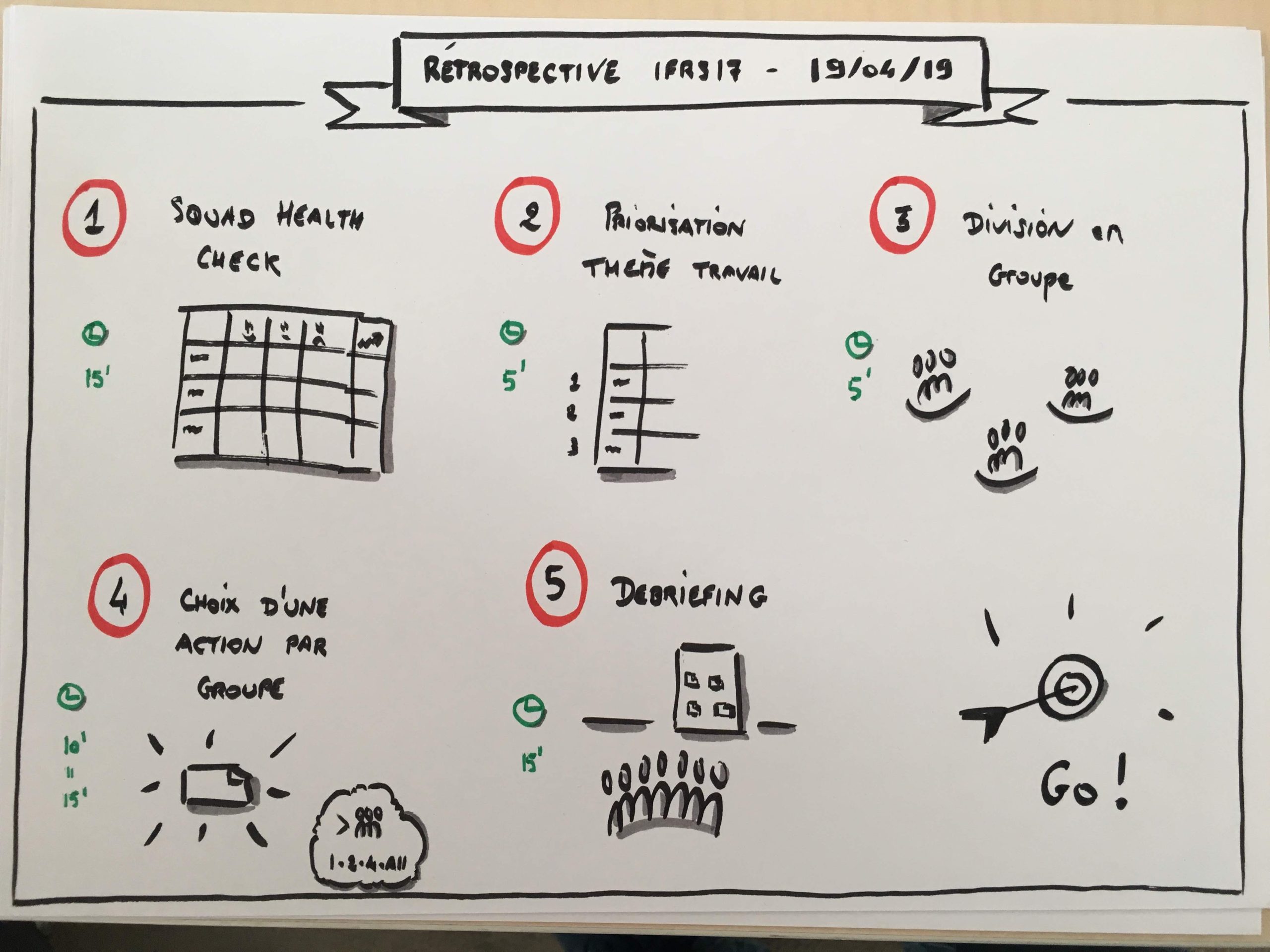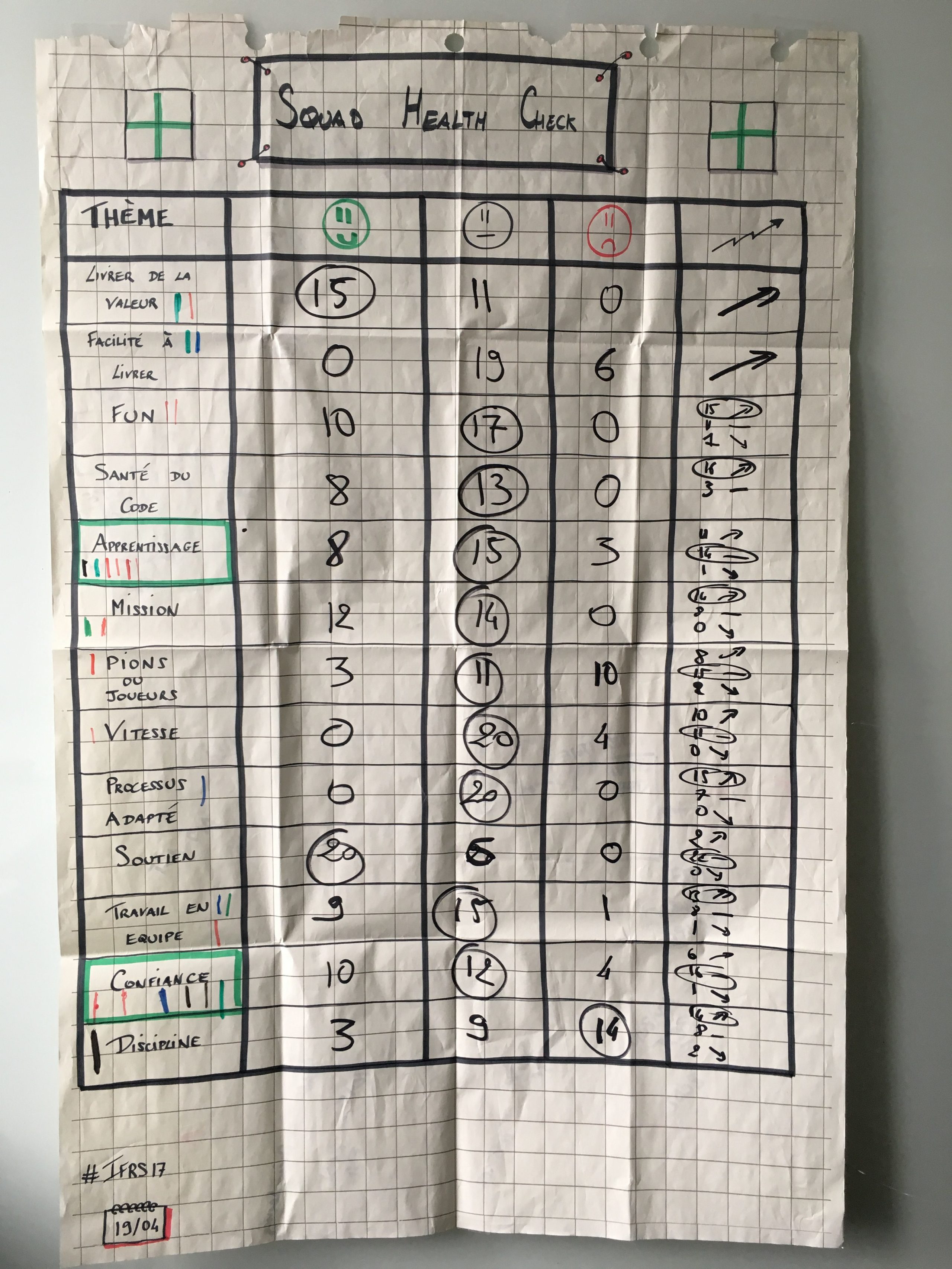Après quelques semaines en présence de cette équipe, il m’est apparu intéressant de prendre du temps pour étudier là où elle en était plutôt que de se ruer sur les potentielles idées d’amélioration.
Je lui ai donc proposé pour cette seconde rétrospective un cadre autour du Squad Health Check afin de pouvoir bénéficier de thèmes plus précis à étudier ensemble.
En voici un descriptif dans ce prochain article !
Dans la même série :
- 30 personnes, une heure : quelques formats de rétrospective (Partie 1)
- 30 personnes, une heure : quelques formats de rétrospective (Partie 2)
- 30 personnes, une heure : quelques formats de rétrospective (Partie 3)
Rétrospective 2 : Squad Health Check

Préparation
- Sélectionner les thèmes du deck original ou traduit du Squad Health Check à soumettre à l’équipe
- Imprimer et découper ces cartes à l’avance afin de préparer le support de résultats sur Paperboard
| Note : Il existe différentes versions de traduction du deck en français. Il s’avère que j’ai choisi celui de Fabrice Aimetti car il comprenait des thèmes supplémentaires qui m’ont apparu intéressants à reprendre dans le cadre de cette rétrospective. Merci à lui ! |
Animation
(2′) Introduction et présentation du cadre
Comme à chaque événement, l’impulsion initiale a énormément d’importance. Je clarifie le cadre et rappelle les intentions ainsi que les règles de la rétrospective en regard de l’itération passée.
(5′) Satisfaction globale sur l’itération

De manière non prévue, je me suis dit qu’il pourrait être intéressant d’avoir un ressenti général de l’assemblée vis-à-vis de l’itération qui venait de s’écouler. C’est également une tentative de ma part de générer plus de transparence au sein de l’équipe.
Pour que cela soit le plus rapide possible, j’ai proposé à chaque personne de se positionner sur une note de 0 à 5 correspondant à son niveau de satisfaction par rapport cette dernière itération :
- 0 correspondant à « s’il y avait une fenêtre, je sortirais probablement par là ! »
- 5 correspondant à « je ne me suis jamais senti aussi bien de ma vie ! »
| Note : bien sûr, cela est dit sur le ton de l’humour ! |
L’intention ici est double :
- permettre à chacun de bien comprendre la règle énoncée
- préparer les participants au Squad Health Check fonctionnant sur le même principe
En terme d’animation, j’ai simplement pris chaque chiffre les uns après les autres et ai demandé directement au groupe les personnes se positionnant à cet endroit à main levée. Je note les résultats au fur et à mesure et laisse les participants prendre acte des résultats.
Après avoir mis en lumière le sentiment actuel de l’équipe, nous passons à l’étape suivante.
(20′) Squad Health Check
Après avoir expliqué le fonctionnement de l’atelier (que vous pouvez retrouver ici), je passe successivement sur les thèmes suivants :
- Livrer de la valeur
- Facilité à livrer
- Fun
- Santé du code
- Apprentissage
- Mission
- Pions ou Joueurs
- Vitesse
- Processus adapté
- Soutien
- Travail en Équipe
- Confiance
- Discipline
Il y a ici beaucoup de thèmes à aborder donc en terme de facilitation, l’idée était de passer rapidement sur chacun d’entre-eux et de matérialiser visuellement les résultats pour l’ensemble de l’équipe.
Les personnes ne se sont pas toutes exprimées pour tous les sujets et j’ai considéré cela ok. En effet, l’idée est simplement d’établir une première base de conversation, on ne cherche donc pas la précision en soi mais plutôt à observer les tendances.
| Note : cela peut particulièrement inconfortable de lever la main pour exprimer un sentiment négatif sur un thème en face d’un grand groupe. Je pris le parti d’espérer que les personnes les plus affectées prendraient leurs responsabilités pour se manifester mais, j’en ai conscience, c’était un pari. Maintenant, cela a plutôt bien fonctionné ! 😛 |
(3′) Vote et sélection de sujets d’étude
Après avoir obtenu tous les résultats, nous procédons simplement à un Dot Voting et nous sélectionnons les sujets d’étude que l’équipe se répartira en sous-groupes.
Voici le résultat de l’équipe en photo :

| Note : Vous pourrez remarquer que ce ne sont pas forcément les thèmes les « moins » bien notés qui ont été sélectionnés. Je pense que c’est ce que j’apprécie dans ce genre d’exercices, c’est que ce n’est pas toujours le rationnel qui l’emporte mais bel et bien ce que l’équipe a considéré comme étant le thème le plus important à étudier ensemble à ce moment là, avec le recul ! 🙂 |
(15′) Travail en sous-groupe
Sans grande surprise, je réutilise la mécanique du 1-2-4-All afin de faire émerger une action par sous-groupe à mettre en oeuvre dans la prochaine itération.
| Note : non seulement cette Liberating Structure m’apparaît comme particulièrement utile mais mon intention est également de transmettre cet outil aux équipes afin qu’ils puissent l’utiliser de manière régulière si besoin, d’où la répétition ! 🙂 |
(15′) Débriefing
Chaque équipe partage les résultats qu’elle a obtenu ainsi que l’action associée. Je facilite quelque peu les discussions par de la reformulation et de la clarification.
On clôture ensuite la session.
Conclusion
Cette rétrospective basée sur le Squad Health Check m’apparaît comme étant un format de facilitation simple et toujours aussi redoutable.
Maintenant, dans le cadre d’une animation avec un grand nombre de personnes, le challenge réside surtout dans la bonne sélection des thèmes à aborder et dans la facilitation de groupe afin de bien respecter ses timeboxes et son timing général.
L’utilisation du 1-2-4-All est probablement la mécanique principale me permettant de gagner un temps précieux dans les phases de réflexion collective : j’accepte par ce biais que tout le monde ne participera pas à toutes les conversations. Dans le même temps, j’espère pouvoir augmenter les chances de mise en oeuvre des actions en focalisant les personnes sur un seul sujet et en définissant une responsabilité collective d’équipe dans le suivi.
Voilà ce qui clôture ce second article de la série.
A la semaine prochaine pour le troisième et dernier article décrivant un autre format de rétrospective que j’ai utilisé avec cette équipe ! 😉






